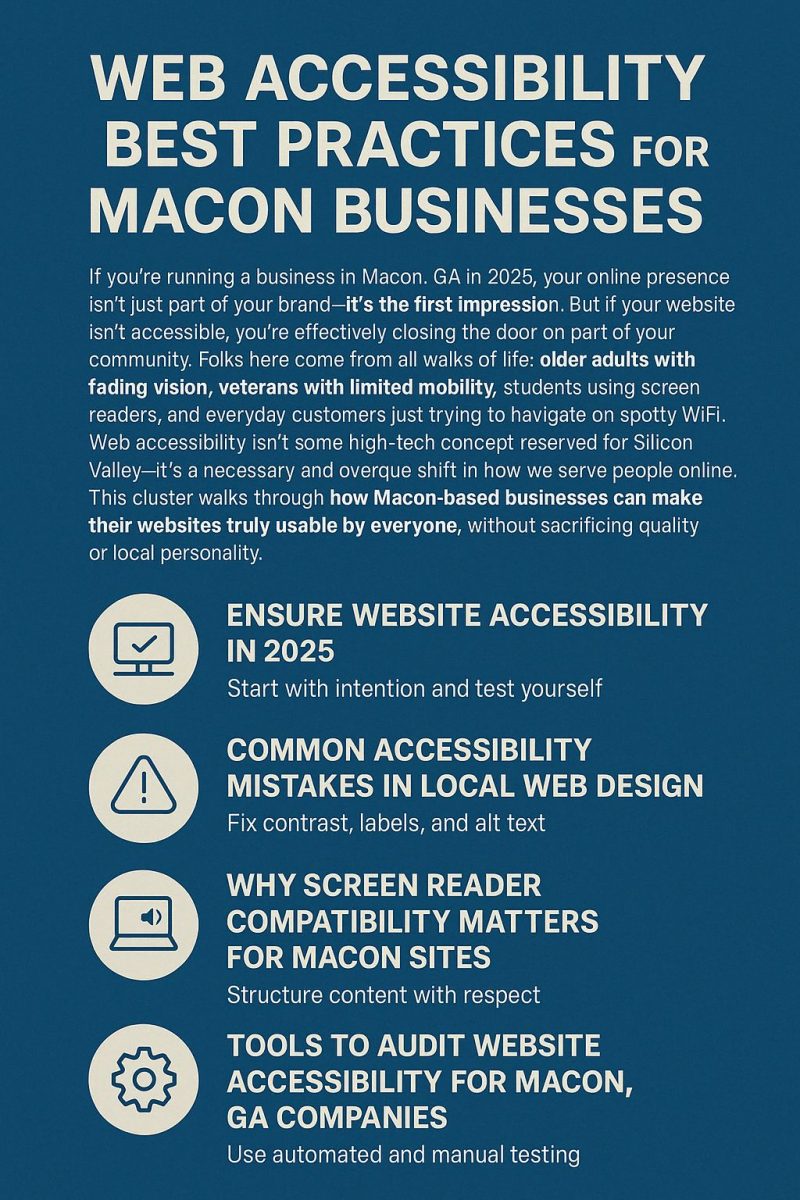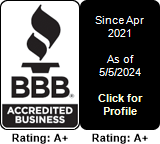If you’re running a business in Macon, GA in 2025, your online presence isn’t just part of your brand. It’s the first impression. But if your website isn’t accessible, you’re effectively closing the door on part of your community. Folks here come from all walks of life: older adults with fading vision, veterans with limited mobility, students using screen readers, and everyday customers just trying to navigate on spotty Wi-Fi. Web accessibility isn’t some high-tech concept reserved for Silicon Valley. It’s a necessary and overdue shift in how we serve people online. This cluster walks through how Macon-based businesses can make their websites truly usable by everyone, without sacrificing quality or local personality.
How Macon Businesses Can Ensure Website Accessibility in 2025
Accessibility starts long before a single page goes live. It begins with intention. And in Macon, that intention matters. This isn’t a town of shortcuts and tricks. People notice when something’s been done right. If you want your website to feel like it’s for everyone, then every part of it has to work for everyone.
That means ditching generic templates and asking the hard questions: Can someone using only a keyboard navigate this menu? Does that soft-gray text even show up for someone over 60? Is the alt text for that hero image just “banner” or something that actually describes what’s there? These aren’t developer concerns. They’re human ones.
Use semantic HTML, not just styled divs. That means buttons are actual buttons, headings follow a logical order, and lists are structured like real lists. Screen readers depend on this logic to deliver a coherent experience. If the markup is chaotic, the user’s experience will be too.
Also, don’t hide information in graphics. Your hours, phone number, or location should never be baked into an image with no text alternative. That’s a fast way to make your site useless for screen readers. The same goes for form fields. Label everything, and make sure required fields are clearly marked and announced properly when errors occur.
Test it yourself. Try navigating with just a keyboard. Try listening to your site with a screen reader. Get feedback from someone in Macon who relies on assistive tech. If you treat accessibility like you treat customer service, with patience, empathy, and realism, you’ll be ten steps ahead of the competition.
Common Accessibility Mistakes in Local Web Design
No one wakes up and says, “Let me design an inaccessible website today.” And yet, it happens constantly. Especially here in Macon, where businesses often rely on site builders that promise speed over substance. The result? Digital barriers that don’t just frustrate people. They shut them out entirely.
Let’s start with contrast. There’s a persistent myth that light gray text on a white background looks “clean” or “modern.” Try reading that in bright sunlight at a coffee shop on Cherry Street. Or with aging eyes at 10 p.m. on a dim tablet. Low contrast is a design trend that hurts real people. Fix it by sticking to strong visual contrast, especially for body text and navigation elements.
Unlabeled form inputs are another huge issue. Macon businesses that rely on appointment scheduling—dentists, mechanics, insurance offices—often use contact forms. But if those forms aren’t labeled correctly, they become unusable for screen reader users. A blank input box with no context is like asking someone to speak in an unfamiliar language.
Missing alt text on meaningful images is common too. It’s not enough to add alt text that says “image” or “graphic.” Be descriptive. Say what the image shows and why it’s there. If you’ve posted a photo of your storefront on Napier Avenue, describe it: “Exterior of Betty’s Florist, brick building with pink awning.” That gives context. That gives access.
Don’t embed essential content inside a PDF without also putting it on the actual page. PDFs are hard to navigate, especially on mobile or with assistive tech. If it’s critical information, put it in plain HTML.
Bad accessibility isn’t just a design flaw. It’s a signal. It tells people you didn’t think about their experience. But by avoiding these simple mistakes, you can flip that message completely and let folks know they’re seen.
Why Screen Reader Compatibility Matters for Macon Sites
If you’ve never used a screen reader, imagine listening to a website like it’s a radio show. You can’t see what’s on screen. You rely on the order, labels, and logic the developer used to build the page. And here’s the thing. Most sites in Macon? They’re not built with that listener in mind.
But they should be.
Macon is home to people of all abilities—students at GAB working with adaptive tech, retirees who’ve lost vision gradually, veterans managing service-related injuries. These folks use screen readers like NVDA or VoiceOver daily. And when your site doesn’t work with those tools, it becomes unusable.
Improper heading structure is the main culprit. If you bold a paragraph to make it look like a heading but don’t actually tag it as an <h2> or <h3>, screen readers won’t recognize it. They’ll read everything out as one long blur.
Identical button or link labels like “Read more” repeated ten times with no context are also dangerous. A screen reader user can’t tell what they’re reading more about. Make your links specific. “Read more about roofing services in Macon” is a thousand times better than vague repetition.
Skip navigation links matter too. These little tools let screen reader users jump straight to the content. Without them, users have to tab through your logo, menu, and search bar every time they load a page. That’s exhausting. And unnecessary.
Compatibility isn’t about coding tricks. It’s about respect. If you wouldn’t ignore someone standing at your counter asking for help, don’t ignore them when they visit your site. Screen reader users are just as likely to become loyal customers, if you give them the tools to stick around.
Making Your Macon Website ADA-Compliant Without Overdesigning
There’s a fear among small businesses that accessible sites will end up looking bland or clinical. That in order to comply with ADA guidelines, they have to ditch creativity. Let’s get something clear. That’s just not true. Especially not in a city like Macon, where design that reflects personality and community still matters.
Start with color. You can use bold colors, gradients, and branding—just test your contrast. Tools like Contrast Checker or Stark make it easy. If your background is orange and your text is yellow, you’ve got a problem. But small shifts in saturation or adding a dark overlay can fix it without changing your brand.
Fonts? Sure, handwritten or script fonts feel friendly. But use them for accents, not main body text. Pair them with clear sans-serif fonts for paragraphs. And don’t go smaller than 16px. You’re not printing a business card.
Dropdown menus and buttons need keyboard support. This is where most off-the-shelf builders fail. They look good, but if someone can’t open or close them using arrow keys and Enter, they’re functionally broken for keyboard users.
Avoid accessibility overlays that promise one-click fixes. They often break more than they help. Instead, bake accessibility into the site’s foundation: semantic structure, usable forms, alt text, and logical navigation. That’s what real compliance looks like. And it’s invisible to users who don’t need it.
Accessible design isn’t boring. It’s just smart. It’s thoughtful. It anticipates needs and solves them quietly. If you do it well, nobody notices. And that’s the point. Inclusion should feel effortless. Especially here, where small touches go a long way.
Tools to Audit Website Accessibility for Macon, GA Companies
No matter how careful you are, accessibility flaws can creep in. That’s why auditing tools are essential. Think of them like tune-ups for your website. And good news. You don’t need to be a developer in downtown Atlanta to run them. You can start today from a back office in Macon with just your browser.
Start simple with WAVE by WebAIM. It’s a free browser extension that highlights missing alt text, contrast issues, skipped headings, and other red flags. It’s visual and intuitive. Perfect for business owners doing hands-on edits.
Google Lighthouse runs in Chrome DevTools. It generates a report showing your site’s accessibility score and offers suggestions for improvement. Think of it as a snapshot, not a full diagnosis.
Axe DevTools offers deeper scans. It’s more technical but incredibly thorough. Developers working on Macon sites should know how to use this. It tests for ARIA role misuse, landmark issues, and more.
Manual testing matters most. Try using your site without a mouse. Tab through menus. Activate links with the Enter key. Use VoiceOver on Mac or NVDA on Windows. That’s how users with disabilities experience your site. Simulate it.
Schedule audits regularly. Accessibility isn’t static. Add a calendar reminder every quarter to re-run your checks. Keep a log. Make it part of your workflow, not a one-time sprint.
In Macon, where people value reliability and word-of-mouth still drives business, an accessible site builds trust that lasts longer than any Google ad ever could.
Want Your Website to Actually Work for Everyone in Macon?
At Southern Digital Consulting, we don’t believe accessibility should feel like a bolt-on. We help local businesses build websites that work quietly, effectively, and beautifully for everyone who visits. Whether you’re revamping your current site or starting from scratch, we build from the ground up with access and inclusion in mind. Let’s make your website a place your whole community can use. Learn more at web design Macon GA.



